There is an urgency in generating change among the clinking of glasses in the vernissages which oscillates, however, in this strange and tedious passivity hoping to wait for the latter to be generated autonomously but continuing to emphasize its importance. We rest on the feeling of political correctness, almost vehemently in the name of a presumed recognition aimed at a certain social class, the same that not only determined its genesis, mindful of glorious past political-cultural achievements, but which also allowed, on the other hand, the simplification of critical language.
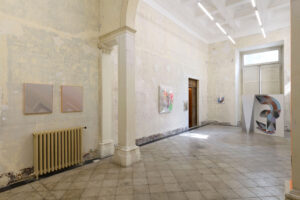
Contestabile, exhibition view, Permeabile, curated by Davide Silvioli, artworks by Alessia Armeni, Monica Mazzone e Mattia Sugamiele; ph. Giorgio Benni, courtesy Contemporary Cluster
It is certain that change, the one with a capital C, happens only if the ideation is transformed into action. We always need, however, a “scapegoat” who raises his voice and who has nothing to lose: the hero who sacrifices himself for the common good trying. We hide behind the disappearance of criticism without specifying that, perhaps, this alleged “crisis” can be determined by a handful of variables. One of these, for example, is the loss the aesthetically refined taste, made by that upper middle class invested by the light of patronage, owner of profit organizations or high-profile companies, which, however, has supported – sometimes even financed – the spread of Kitsch, riding the economic-industrial wave of those specific times there. A second one, in my opinion more important, is that criticism is not only something that clings to excessive favoritism, to the pompous and almost deified logic of lavishly plethoric editorial statements, such as “this work is extremely contemporary …”, but an act that claims that causal preposition that, from that sterile annunciation, considers the same numerous variables and possible contexts in which it is inserted. The quid that determines “why” that work is extremely contemporary, which is too often confused with “what” or “how”, which are inevitably uncritical, descriptive.
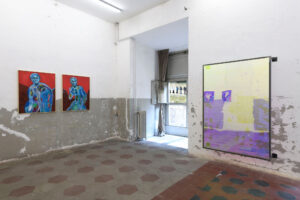
Contestabile, exhibition view, Post Scriptum, curated by Davide Maria Mannocchi, artworks by Davide Serpetti e Valerio D’angelo; ph. Giorgio Benni, courtesy Contemporary Cluster
And here we find the group show Contestabile, currently ongoing at Contemporary Cluster, whose artistic direction is entrusted to Giacomo Guidi in the monumental Palazzo Brancaccio in Rome. Observing its structure silently, from afar, Contestabile is already in itself a contextualized change. On the one hand, in the choice to insert no longer a single big as a curator, but entrusting to three emerging curators (Davide Silvioli, Niccolò Giacomazzi, Davide Maria Mannocchi) together with nine artists (Alessia Armeni, Genuardi/Ruta, Mattia Sugamiele, Monica Mazzone, Dario Carratta, Flavio Orlando, Wang Yuxiang, Valerio D’Angelo and Davide Serpetti), giving them the task of creating a narrative that can accept its hypothetical contestability.
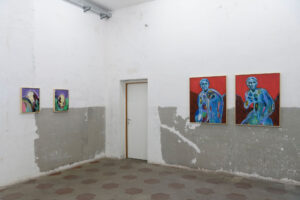
Contestabile, exhibition view, Post Scriptum, curated by Davide Maria Mannocchi, artworks by Davide Serpetti e Valerio D’angelo; ph. Giorgio Benni, courtesy Contemporary Cluster
I would start from a brief reflection by Mannocchi, written in the curatorial text of the third and last room, curated by him and entitled Post Scriptum: «Criticizing is the first act of the doctor who seeks care for the afflicted patient. By analogy, the same is true about history. When a certain epoch is “in crisis”, it means that it is committed, perhaps still unconsciously, to emancipate itself from itself». Now, the reader will agree with me that, reading these few lines, it is not so much the criticism that has disappeared, but that, perhaps, only the means of its diffusion has changed, and therefore the attention and care that is placed on it. A simple sheet in a gallery contains a profound reflection that we tediously carry in our pockets and perhaps destined to be read by a few. The critic is therefore a careful and scrupulous observer of history, never presumptuous but resolute, and those who maintain that his glory derives from his aesthetic judgment, are the same who forget that sheet in that pocket. The juxtaposition between the five pictorial works by Davide Serpetti and the mirrored surfaces by Valerio D’Angelo invites the figuration to reflect and deform, to confront its double, a Narcissus (2023) transformed into a mirror (Valerio D’Angelo) and flatterer of its immortal shadow, although always alert and paranoid in finding and competing with that of others. It is a figuration, that of Serpetti, which underlines the dedication to the study. The artist is creator of his own transformation and spokesman of a plasma temporality carried on the shoulders as from an Atlas poised between a classical iconography and a deeply contemporary dysmorphism proper to the post-human era. If in the i Vinti series (2022-2023), previously painted by Serpetti for his exhibition at the Sanctuary of Hercules Victor in Tivoli, the figuration, blurred and frozen in the canvas, seems to remain struck and devoid of iris, almost blinded by the “magic of doing” but unable to spread it, in Sculpture of anything goes #1 and #2 (2023), present in the exhibition, it opens its eyes, aware of its transformation, and turns forward. The gaze is the conscious act of the imminent change, the same that in Lucifer (1890) by Franz Von Stuck insists, against that conservatism of that official art, disturbing on that of the observer, crossed and filtered by the reflective and polychrome surfaces painted by D’Angelo.
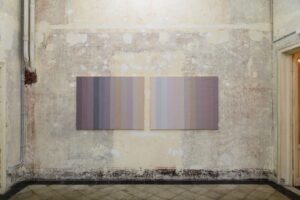
Contestabile, Permeabile, a cura di Davide Silvioli, opere di Alessia Armeni, serie 24h_painting_rome_12_04_2021, photo credits: Giorgio Benni, courtesy Contemporary Cluster
The polymorphic oscillation of a hybrid figuration is also synthesized in the geometric shapes of Monica Mazzone‘s works in Permeabile the first room curated by Silvioli. An emotional and spiritually symbolic geometry for Mazzone (Deconstruction of a beginning, A moment before a moment after, 2022), which investigates how to permeate the two-dimensionality of the image, without leaving behind its sculptural making. Geometry, in search of an essential purity, abandons morphological-formal rigidity, stretching and deforming. Mazzone’s works thus alternate the coexistence of a linear and rigid fragmentation with a curvilinear fluidity. To underline this reflection is Silvioli himself, arguing that this permeability qualifies the artwork as a synthesis of these two variables in contrast but not in contradiction, which, therefore, come to contaminate, even to conflict, and then merge and never to cancel each other. If for Mazzone the contamination between painting and sculpture alters the space-physical perception of the room, for Alessia Armeni, in the diptych 24 h_painting_rome_12_04_2021, the regular spectrometric geometry marks its temporality. Twenty-four vertical expanses of warm polychromes represent a sampling of atmospheric brightness that is projected on a wall over the course of a day lived by the artist in a Roman studio.

Contestabile, exhibition view, La distanza tra pubblico e privato è di 37 cm, curated by Niccolò Giacomazzi, artworks by Flavio Orlando e Wang Yuxiang; Ph. Giorgio Benni
«Analyzing the themes of a modernity characterized by an irrepressible dualism of antithetical and divergent elements, the works and, consequently, an exhibition become a necessary tool to aggregate the multitude at the center of the debate». What Niccolò Giacomazzi said in the critical text of his room, entitled La distanza tra pubblico e privato è di 37 cm, seems to apply perfectly to the two canvases that face each other: Attraverso il buco (2023) by Flavio Orlando and La notte degli oggetti desiderabili (2023) by Dario Carratta. The 37 centimeters that separate two antithetical dimensions, or perceived as such, are a distance that can be traveled by artists, who try to place themselves at the meeting point. Crisis means openness, possibilism and aggregation, in fact; in Giacomazzi’s room coexist, or perhaps collide, the opening of the private even more intimate, an act of explicit dejection, and a public that calls together the collective unconscious. The crisis is openness, or its opposite, because Wang Yuxiang’s “hundred billion suns” experience the incommunicability of closed windows.
Info:
Contestabile
Permeabile
(Alessia Armeni, Genuardi/Ruta, Mattia Sugamiele, Monica Mazzone)
curated by Davide Silvioli
La distanza tra pubblico e privato è di 37 cm
(Dario Carratta, Flavio Orlando, Wang Yuxiang)
curated by Niccolò Giacomazzi
Post Scriptum
(Valerio D’Angelo, Davide Serpetti)
curated byi Davide Maria Mannocchi
Contemporary Cluster
Palazzo Brancaccio, Via Merulana, 248, Roma
07.06. – 12.07.2023
https://www.contemporarycluster.com/contact-8
e-mail: https://www.contemporarycluster.com/
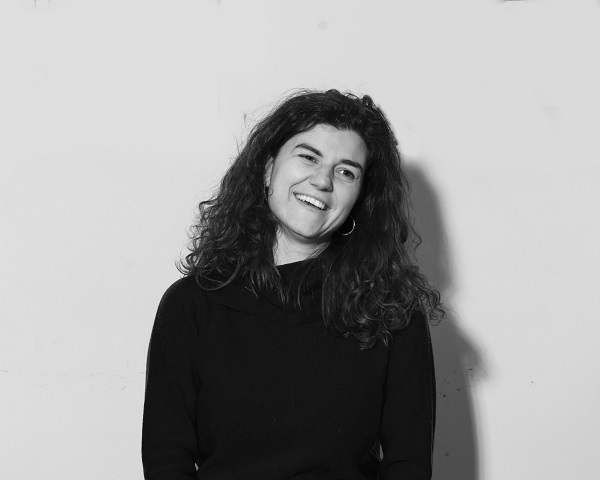
Graduated in Architectural Sciences at the Sapienza University in Rome, with a master’s degree in Contemporary Art and Management at the Luiss Business School, she currently works as an intern and project manager at Untitled Association. Graduated in Photography and Art Criticism in Bologna, she currently carries on her personal projects and is part of the team of the Forme Uniche cultural project.






NO COMMENT